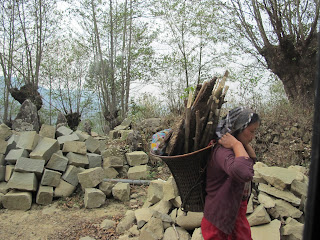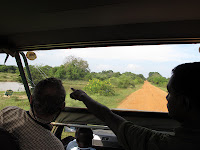Ao Nagas are the tribe whose settlements are spread across the Mokokchung district. It seems that the major tribes are in their own districts. The sixteen main tribes of Nagaland are Angami, Ao, Chakhesang, Chang, Dimasa Kachari, Khiamniungan, Konyak, Lotha, Phom, Pochury, Rengma, Sangtam, Sumi, Yimchunger, Kuki and Zeliang. The Konyaks, Angamis, Aos, Lothas, and Sumis are the largest Naga tribes.
Tribe, clan traditions and loyalties play an important part in the life of Nagas. Our drive yesterday, our excursions today, and our long drive tomorrow to Mon have all been along the Saramati mountain range which separates Nagaland from Myanmar(Burma). Yesterday we drove through territory of the Rengma and Lotha tribes but did not stop to visit villages.The area where they were burning the fields was in Ao territory.With today being Easter Sunday we had a lovely Easter sunrise (4:30am) chorus of appropriate hymns that David recognized even though they were being sung in the Ao language from the Baptist church below our hotel. Today we went out to the villages of Ungma, Longkhum, and Mopungchuket.
 On reaching Ungma we went first to see the village log drum and also the morung which had a stone out front with writing in the Ao language script, which uses Sanskrit letters. The Angami tribe uses the Latin alphabet. Log drums are whole trees that have been cut down and then hollowed out. They served a variety of functions, including inter-village communication, warning a village in case of attack, and ceremonial purposes. Log drums were mostly used by the more northerly Naga tribes, such as the Ao's and the Konyaks. The Angami's don't use log drums.
On reaching Ungma we went first to see the village log drum and also the morung which had a stone out front with writing in the Ao language script, which uses Sanskrit letters. The Angami tribe uses the Latin alphabet. Log drums are whole trees that have been cut down and then hollowed out. They served a variety of functions, including inter-village communication, warning a village in case of attack, and ceremonial purposes. Log drums were mostly used by the more northerly Naga tribes, such as the Ao's and the Konyaks. The Angami's don't use log drums. We heard a familiar choir song coming from the large village church so we went inside and had some reflective time in the church at the back while the choir practiced. Many villagers were coming to church in their traditional dress, different in color and weaving style than the Angami.
We heard a familiar choir song coming from the large village church so we went inside and had some reflective time in the church at the back while the choir practiced. Many villagers were coming to church in their traditional dress, different in color and weaving style than the Angami.
Weaving has been a traditional art handed down through generations and the different tribes have different styles and colors that they use in their weavings. The Ao Nagas clothing used to serve visually to distinguish the warriors and commoner class. The Ao Naga warrior shawl is called Mangkotepsu. This is exclusively worn by the men folk. In the past a man had to earn the right to wear this shawl by taking human heads in warfare, through acts of bravery and by offering by feasts of merit as proof of his wealth. Anyone wearing it without the credentials was taken to task by the village council and had to pay heavy penalties for violating the code.
 |
| Ladies waiting to go into church |
The white strip in the middle carries the embroidered symbols of bravery and courage and the sun, moon and stars signify the resulting fame of such warriors. The animals depicted in the strip resemble the physical power and the valor of men. The hornbill is a revered bird whose feathers are used for decorative purpose in ceremonial costumes. The bison indicates the wealth of the wearer because only the rich people could rear these animals. Other symbols are depiction of weapons and shields used by Ao men during warfare. We were shown into a home with bamboo floors where a woman had some shawls for sale. Unfortunately the previous weavers we had met were so exceptional Leslie had no interest at all in the products being offered, which were much more modern versions of the old and now using metallic threads etc.
 |
| Detail of Mangkotepsu Shawl |
 |
| Man with traditional bowl haircut and shawl |
The Ao Nagas were the first tribe to convert to Christianity. The American Baptists Edwin Clark and wife Mary operated among the Ao Nagas starting in the early 1870s. The Ao are sometimes referred to as the "Brahmins" of the Nagas, as, because of the missionaries, the Aos were the first Nagas to receive English education and therefore became rather more prosperous than some of their neighbors.
In the second village of Lengkhum we had tea with a lady who showed us her traditional clothes and the quality was much better than the previous village. The colors of the shawls were different in this village, these being a bright blue and the red skirt being striped with blue. The basket types also vary by tribe.
 |
| Ao Basket rides very high on the head |
We had lunch back at the hotel as it is Easter Sunday and nothing was open. We were busy enjoying our wireless Internet while we waited the hour for our food to arrive. After lunch we drove to the village of Mopangchuket. The town was previously known as Impur where the one of the first
 |
| Man's knives for forest and other work |
 |
| Detail of weaving for Ao women's skirt and shawl |
Tomorrow we have a 7 - 8 hour drive to Mon where we will be staying at a home stay. Given the accommodation for the next 2 nights will be small buckets of boiling water we will enjoy another shower here before we leave.








































